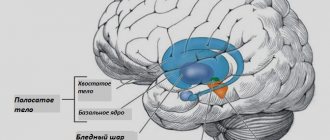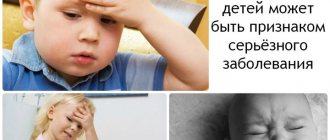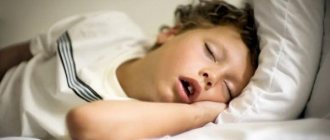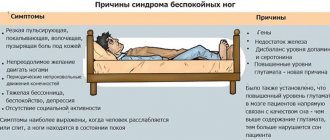Symptoms of chorea
The disease may not manifest itself immediately. But the symptoms of chorea are usually pronounced and poorly similar to the manifestations of other disorders of the nervous system. The onset of the attack is characterized by weakness, the patient cannot stand or move, the muscles weaken and lose tone. The characteristic symptoms of chorea resemble completely natural movements of the face and limbs, smiles, grimaces and other facial expressions. But all this is done involuntarily and uncontrollably by man. In severe cases, chorea in children leads to speech impairment, irreversible consequences occur in the cerebellum, which lead to impaired coordination of movements.
As for the patient’s mental state, it also changes with Genington’s chorea. Memory weakens, mental activity is disrupted, attention is distracted, and mood changes dramatically. Hallucinations and delusional ideas appear. Relief occurs while the patient sleeps, but, as a rule, it is difficult to fall asleep due to the symptoms of chorea.
Mental disorders accompanying Huntington's disease
Main danger
chorea is a mental disorder.
Along with hyperkinesis, they are the most characteristic sign of the disease:
- Emotional lability
, unstable mood, depressed mood are
symptoms
that are caused by a decrease in the amount of excitatory neurotransmitters. - Memory impairment
in the form of anterograde amnesia - the patient has difficulty remembering new information and has difficulty distinguishing faces. - Hyperkinesis of the facial muscles
makes speech slurred and filled with extraneous sounds. It is often impossible to understand what the patient is talking about. Changes may also affect the patient’s thinking - the inability to clearly formulate one’s thoughts makes communication with him very difficult, sometimes almost impossible. - Depression with chorea is of a pronounced
progressive nature, accompanied by suicidal thoughts and attempts, so strong that suicide often becomes the cause of the patient’s death. Apathy, delusional ideas of self-blame, and unmotivated aggression may also develop. - Dementia develops in the later stages
, when there are already pronounced hyperkinesis and mental disorders. Memory impairment occurs, the patient stops remembering people’s faces, loses the ability to care for himself, eat, dress independently, and maintain personal hygiene. - Bad habits, such as alcoholism
, intensify with chorea and lead to even greater destruction of the patient’s personality.
Methods for diagnosing chorea
To diagnose Henington's chorea or rheumatic chorea, you need to undergo a series of tests. To prescribe the correct treatment for chorea, a blood test will be required. Based on its results, you can determine whether the level of white blood cells is high or low, as well as whether a streptococcal infection is present. Rheumatoid causes of chorea can also be detected by blood. In the process of diagnosing Henington's chorea, the doctor will definitely study the medical history of the parents of the sick child to determine whether heredity is the cause of its exacerbation.
During the examination, an electroencephalogram and magnetic resonance imaging are used. Chorea in children and adults is also diagnosed using computed tomography.
Chorea in children: how to diagnose and promptly treat a nervous disease
Content
During the deep Middle Ages, chorea in children was designated as a form of possession. And the unfortunate man was treated accordingly.
When the time of obscurantism was left behind, it became clear that this pathology had nothing to do with mysticism.
Have you ever experienced unbearable joint pain? Judging by the fact that you are reading this article, you or your loved ones are faced with this problem. And you know firsthand what it is:
- inability to move easily and comfortably;
- discomfort when going up and down stairs;
- unpleasant crunching, clicking not of your own accord;
- pain during or after exercise;
- inflammation in the joints and swelling;
- causeless and sometimes unbearable aching pain in the joints.
During the deep Middle Ages, chorea in children was designated as a form of possession. And the unfortunate man was treated accordingly. When the time of obscurantism was left behind, it became clear that this pathology had nothing to do with mysticism.
Features of therapy in the treatment of chorea
Treatment for chorea prescribed by your doctor must be followed exactly. The danger of some forms of the disease, in particular Henington's chorea, is frequent relapses. Therefore, you cannot neglect the advice of doctors. It is very important to register them with a dispensary before chorea develops in children suffering from rheumatism. This allows, in some cases, to minimize the chance of developing severe chorea in children and adults.
Therapy for the treatment of chorea includes a number of drugs. These are antipsychotic and sedative drugs, anti-inflammatory and antiviral drugs, antihistamines and vitamins, agents for dilating blood vessels and improving brain function. In severe cases of Henington's chorea, antibiotics are used. Additionally, when treating chorea, physiotherapeutic procedures, therapeutic radon baths, and pine needle baths are prescribed.
The effectiveness of treatment for chorea depends on how correctly and timely the main cause of the development of this disease is identified. Doctors do not recommend planning the birth of children for people who have a family history of chorea. If symptoms of chorea appear during a woman’s pregnancy, then the chances of giving birth to a healthy baby are reduced. There is no point in planning a second pregnancy.
Parents of children with manifestations of this disease should be very attentive and careful in conversations and behavior. You cannot provoke irritation of his nervous system with screams and negative emotions.
Video from YouTube on the topic of the article:
Chorea minor is a disease that manifests itself as a rheumatic infection of a neurological nature. Minor chorea is also called Sydenham's chorea, rheumatic or infectious chorea. In a sense, this is encephalitis of the rheumatic breed. This brain disease is of muscular origin and manifests itself in the form of hyperkinesis, which develops as a consequence of damage to the brain structures that provide the function of coordination of movements and are responsible for muscle tone. The disease is based on damage to the blood vessels of the brain, mainly affecting the subcortical nodes. Lesser chorea rheumatically affects the heart.
According to statistics, girls get sick twice as often as boys. Manifestation occurs between the ages of 6-15 years, often during the cold season. The fact of a more frequent incidence in girls is associated with the hormonal characteristics of the growing body and the production of female sex hormones. Of significant importance is the fact that the cerebellum and striatal brain structures are involved in the pathological process. It manifests itself in the form of uncontrolled attacks, the duration of which is about three months, in some cases it can last up to six months or even several years. Minor chorea may recur.
Small chorea also affects adults aged 30-45 years. In this case, the clinical picture is accompanied primarily by severe mental disorders, most often irreversible.
Huntington's chorea disease - what is it?
Under the term "chorea"
, especially when it comes to children, often mean any hyperkinesis that occurs as a result of a previous injury or infection of the brain, as well as congenital diseases, for example, cerebral palsy.
Huntington's disease
- This is one of the types of chorea that occurs as an independent disease, and not as a symptom of other lesions.
Refers to hereditary hyperkinesis, with it the development of motor and mental disorders.
It manifests itself:
- in the form of obsessive movements
that the patient does not control; - decreased muscle tone
and development of paresis; - mood swings
, depression and other severe symptoms.
Its name is Huntington's chorea
received in honor of the American psychiatrist who first described her symptoms. The disease is inherited; according to statistics, the disease appears more often in children if their fathers suffered from chorea, and less often in mothers.
The basis of the pathogenesis of chorea
According to modern medicine, there is a violation of DNA synthesis in neurons - the appearance of extra sequences of three nucleic acids. As a consequence, in one of the proteins synthesized in the nervous tissue, additional glutamine molecules appear in the amino acid sequence.
Defective protein
does not perform its function and leads to the death of the neuron. As a result of massive death of neurons, motor and mental disorders are formed.
It affects the striatum - the brain structures responsible for the tone of skeletal muscles and the coordination of involuntary movements. These same structures are involved in the implementation of motor stereotypes, for example, walking or other actions that a person performs without thinking. It is in the striatum that the concentration of pathological proteins sharply arises.
The disease is chronic and progressive
, that is, the patient’s condition deteriorates more and more over time, restoration of damaged functions does not occur, but on the contrary, new symptoms appear.
Huntington's chorea disease in children
Despite the fact that chorea
– a hereditary disease, its manifestations in children are quite rare. In children, other types of chorea are more common, caused by congenital or acquired disorders in the functioning of the brain.
Chorea can be caused in children by:
- Cerebral palsy
, previous encephalitis, including tick-borne encephalitis;
brain injuries- rheumatic
diseases; - a rather rare
congenital defect - Wilson-Konovalov disease; - copper metabolism disorder
, which is accompanied by other symptoms in addition to chorea.
If a child develops Huntington's chorea,
then it tends to be more severe, with a rapid increase in symptoms. In addition, a child, unlike an adult, cannot control the manifestations of the disease through willpower, so in him these manifestations are much more noticeable.
One of the characteristic symptoms is periodic convulsive seizures, which, unlike epileptic seizures, are not accompanied by loss of consciousness and amnesia.
Some of the drugs used in adults and children with Huntington's chorea
This is not possible, so it is more important for children to follow a regimen and diet that does not allow the course of the disease to worsen. It is also important to take medications strictly as scheduled.
A child with chorea
may attend school only with the permission of his attending physician. If the course is severe, he is transferred to home schooling.
Huntington's chorea minor
Lesser chorea is called hyperkinesis
, arising as one of the manifestations of rheumatism. Despite the similarity of symptoms, it is very indirectly related to Huntington’s disease.
Chorea
, unlike Huntington's disease, develops in children and adolescents, less often in young men suffering from rheumatism.
The basis of the disease is not genetic mechanisms, but autoimmune ones
– rheumatism develops when the body’s own tissues are damaged by the body’s immune system after a staphylococcal infection. Minor chorea is not present all the time, but only during an exacerbation of rheumatism.
Symptoms of minor chorea
– sweeping involuntary movements of the limbs, torso, head, an important feature – facial muscles are usually not involved.
The intensity of attacks of minor chorea does not change or decreases; in most patients, attacks stop several years after puberty. Mental disorders do not occur. In general, chorea minor is much less dangerous to the health and life of the patient than Henryton's disease.
Causes of minor chorea
The disease is infectious in nature. It has been established that the cause of the development of minor chorea can be considered an infection with group A beta-hemolytic streptococcus. This infection mainly affects the upper respiratory tract and provokes the development of tonsillitis and tonsillitis. In the process of fighting the disease, the human body produces antibodies that fight streptococcal bacteria. Sometimes a so-called autoimmune response occurs - simultaneously with these antibodies, antibodies to the basal ganglia of the brain also begin to be produced. Next, an attack occurs by the nerve cells of the basal ganglia, which provokes inflammatory processes in the subcortical formations of the brain, which manifest themselves in the form of hyperkinesis.
The main provocateurs of the production of antibodies to the basal ganglia of the brain can be considered:
- genetic predisposition;
- instability of the nervous system, for example, excessive emotionality;
- hormonal imbalances;
- weak immune system;
- development of inflammatory processes in the upper respiratory tract;
- dental caries;
- thin body structure.
The presence of beta-hemolytic streptococcus can provoke the production of antibodies to other structures of the human body (heart, joints, kidneys), and cause rheumatic damage to these organs. This will be the reason for considering the disease as a variant of the rheumatic process as a whole.
Modern neurology is still exploring the question of the nature and cause of the development of chorea minor. The assumption about the infectious nature of the disease was made at the end of the 18th century by the scientist Stol. Today this issue is still under research.
Story
The engraving by Hendrik Hondius depicts three women affected by the dancing plague.
The term “trochaea” comes from ancient Greek. χορός - dance, dance[4]. At first, the meaning of this term differed from the modern one: since the 13th century, “chorea” (“choreomania”) was a psychogenic movement disorder - dissociative convulsions, sometimes widespread among the medieval population in the form of “epidemics of dancing.” Groups of people afflicted with dance mania performed dance-like movements against a backdrop of narrowed consciousness, probably throwing out the nervous shock caused by the plague epidemics.[4]
St. Vitus became associated with chorea for several reasons. In the 9th century, after miracles that occurred during the transfer of his relics from Saint-Denis to Saxony, the cult of this saint arose as the patron saint of patients suffering from epilepsy and chorea. People with these disorders went on a pilgrimage to one church or another on the feast of St. Vitus and danced there to overcome their fears and pain[5]. In the 16th century, a belief spread in the Holy Roman Empire that whoever danced in front of a statue of a saint on his name day (June 15) would receive a charge of vigor for the whole year. Therefore, on this day, many people danced emotionally near such statues. Residents of Strasbourg, gripped by the dancing plague in 1518, were directed by the magistrate to the chapel of St. Vitus in Zabern (now Saverne
), where their “healing” took place[6].
For the first time, separately from psychogenic types of chorea, minor chorea under the name chorea naturalis (from Latin - ““real” chorea”) was described in the 16th century. Paracelsus[4]. Children suffering from rheumatic chorea were first described by Gregor Horst (German) in 1625[7].
One of the names of chorea comes from St. Vitus, a Roman martyr of the early Christian period.
Thomas Sydenham in 1686 first identified rheumatic chorea as a separate childhood disease and a special form of hyperkinesis, and also very accurately and in detail described its main symptoms [4]. As a synonym, he used the term “St. Vitus’s dance,” which from that time began to have a new meaning [8]. This caused some confusion, since the same term also meant organic disease ( minor
, or
English chorea
), and psychogenic disorder (
large
, or
German chorea
).
Despite the fact that Sydenham also described rheumatic fever and its joint symptoms, he did not find a connection between it and chorea [9]. William Osler is one of the most famous researchers of chorea minor.
The English doctor Bright first attributed chorea minor to manifestations of rheumatism in 1831 [4]. However, chorea minor finally became a delineated nosological entity only in the second half of the 19th century. In the late 1860s, J. Jackson and W. Broadbent were the first to determine that the cause of Sydenham's chorea was dysfunction of the striatum. At the same time, they mistakenly believed that the dysfunction of the striatum was caused by its embolism. In 1887, William Osler presented 410 cases of clinical observations of rheumatic chorea, and in 1894 he published the monograph “On Chorea and Choreiform Affections” - one of the most widely cited North American studies of the 19th century, which showed its connection with rheumatoid arthritis and endocarditis [4 ]. In his book, he clearly separated psychogenic (“major”) chorea from rheumatic (“small”) chorea [9]. W. Govers, one of the first researchers of chorea as a neurological syndrome, in the book “Manual of the diseases of the nervous system” (1886-1888), along with other forms, described Sydenham’s chorea, based on his experience of treating 120 patients suffering from it diseases at the National Hospital for the Paralyzed and Epileptic. In 1894, diplococcus was isolated from the brain of a person who died from chorea minor. Based on the results of further research, during which it was possible to sow various cocci, scientists suggested that chorea minor is a bacterial meningoencephalitis. However, the fact that bacteria could not always be isolated raised doubts about the correctness of this theory [9]. The discovery in the early 1930s that antistreptolysin O is a marker of bacterial infectious processes caused by group A streptococci made it possible to establish that all manifestations of acute rheumatic fever, including chorea minor, are the consequences of a previous streptococcal infection. The discovery of antibacterial drugs made it possible to focus on the fight against the infectious agent that led to the development of rheumatic chorea. Since the 1930-1940s, the use of sulfonamides and penicillin has made it possible to carry out not only treatment, but also primary and secondary prevention of rheumatism, therefore the incidence, including minor chorea, as one of its manifestations, has fallen [9]. In 1976, research by G. Husby and his colleagues demonstrated that Sydenham's chorea is not caused by infection per se, but is the result of a violation of immune mechanisms.
Symptoms of minor chorea
The clinical picture of minor chorea is visible within a few weeks after suffering an infectious disease (tonsillitis or tonsillitis).
The main clinical manifestations of chorea minor are motor disorders (involuntary twitching of the arms and legs). This is called choreic hyperkinesis - rapid, chaotic, uncontrolled muscle contractions. Choreic hyperkinesis can manifest itself in the face, hands, and limbs in general. They can affect the larynx and tongue, the diaphragm, or even the entire body at the same time.
At the initial stage, hyperkinesis is almost invisible, very often they are not paid attention to. Clumsiness and numbness in the fingers or subtle twitching of the facial muscles may at first be perceived as a child grimacing. Twitching becomes more noticeable with excitement or other emotional outbursts. Over time, hyperkinesis becomes more pronounced and prolonged, and can manifest itself in the form of a so-called “choreic storm,” when uncontrollable twitching occurs simultaneously throughout the body.
To diagnose the disease as early as possible, it is necessary to pay attention to the symptoms of the following hyperkinesis at the very beginning of their manifestation:
- Awkward movements when writing or drawing. The child has difficulty holding a pencil or brush, cannot concentrate to draw a straight line, makes blots, makes more marks than before; Sometimes you can observe the “milkmaid” syndrome, when the hands involuntarily clench and relax.
- Uncontrollable antics (tongue sticking out, grimacing). Many attribute these signs to the child’s bad manners, but if other types of hyperkinesis are present, then they are worth paying attention to.
- Inability to hold a given position for a long time.
- Involuntary shouting of words or sounds. This may be due to contraction of the laryngeal muscles.
- Unclear and mixed words when speaking. This can be explained by involuntary contractions of the laryngeal muscles and tongue. If a child who was not previously distinguished by defective speech suddenly begins to pronounce words unclearly, speech becomes inarticulate, then you should contact a neurologist, especially if other signs of hyperkinesis have been noticed.
In severe cases, hyperkinesis of the muscles of the larynx and tongue leads to a complete absence of speech (“choreic mutism”).
Sometimes hyperkinesis also affects the respiratory muscles of the diaphragm. In this case, the so-called Cherny syndrome or paradoxical breathing occurs. When you inhale, the stomach sinks inward, and does not protrude, as is normal. The child cannot concentrate his gaze on one object. The eyeball constantly runs in different directions.
As hyperkinesis progresses, self-care (eating, dressing, walking) becomes difficult. Signs of hyperkinesis disappear when the child sleeps, but the process of going to sleep is accompanied by certain difficulties.
Clinical picture
| External video files | |
| Sydenham's chorea in rheumatism (subtitles in English) (English) | |
Most often, Sydenham's chorea is accompanied by other acute rheumatic fever syndromes, such as carditis (75% of cases) and polyarthritis, but in 5-7% of cases it is the only manifestation of rheumatism (isolated, or “pure” chorea)[8]. It occurs 1-8 months after a streptococcal infection or exacerbation of rheumatism[15]. More often, rheumatic chorea develops in patients with a burdened neurological history.
As a rule, the disease begins subacutely, and only sometimes rapidly, within a few hours, with behavioral disorders (increased irritability, emotional lability), clumsiness of movements and difficulty writing. Patients become fussy, their sleep is disturbed, headaches, dizziness, and hyperesthesia are often noted. Often the patient’s parents consider the first manifestations of the disease to be a “prank” or a “bad habit”, and only with the development of the disease do they realize their pathology. Minor chorea can begin with mental disorders[16]. Very rarely, rheumatic chorea can begin with seizures, cerebellar, pyramidal disorders and papilledema[8]. Damage to the cranial nerves is sometimes observed. tendon and periosteal reflexes are reduced or uneven, pathological - absent. Sensitivity disorders are not observed[17].
Features of choreic hyperkinesis
Depiction of boys suffering from Sydenham's chorea (1880s).
General characteristics of choreic hyperkinesis in Sydenham's chorea: prevalence (generalization), irregularity and disorder, lack of coordination, involuntariness (they cannot be stopped by willpower), persistence, intensification with excitement and voluntary movements, and disappearance during sleep [1]. The intensity of choreic hyperkinesis depends on emotional stress[18]. As a rule, choreic hyperkinesis occurs in the facial muscles and distal limbs, and then spreads to other muscle groups. Usually they are generalized, less often - asymmetrical, and only in 20% of cases - unilateral [8]. At the beginning of the disease, involuntary movements are single, short-lived, mild and intensify only with excitement, then they become generalized, and in the advanced stage of the disease they are observed almost constantly, disappearing only in sleep and with drug sedation (“ mad dancing”
"[1], "
trochaic storm
"[17]). In such cases, the patient cannot walk, stand, sit, or eat. Choreic hyperkinesis is observed in different muscle groups. For example, one of their manifestations is the symptom of “milkmaid’s hand” - the hands alternately clench and relax, as if during milking[19]. In patients, gait is disturbed, sometimes taking on the character of dancing and jumping, saltatory spasms are observed (lat. spasmus saltatorius - dance spasm: when the patient tries to stand on his feet, a clonic contraction of the muscles occurs and he jumps, less often such a contraction occurs when touching the soles of the feet while lying down) . In 15-40% of cases with minor chorea, pronunciation is impaired due to involuntary muscle contractions, and in severe cases, swallowing is impaired. Due to involuntary contractions of the muscles of the larynx, the patient may make mooing sounds. Sometimes speech is so difficult that choreic mutism occurs - the patient completely abstains from speaking [1]. Fasciculations of the tongue (“bag of worms”) may be observed. The following “small” forms of hyperkinesis (“micro-hyperkinesis”) are described[2]:
- symptom of “eyes and tongue”, or “chameleon tongue” (“snakes”, “flycatchers”, “trombone tongue”) [20] - the tongue stuck out with closed eyes cannot be held for longer than 15 seconds, it immediately returns to the mouth;
- symptom (test) of the “ring” by S. F. Rozin - it is difficult for the patient to keep the distal phalanges of the thumb and other fingers connected in the form of a ring [18].
- symptom of “shaking hands” by N. F. Filatov - when shaking hands, the doctor feels uneven tension in the patient’s muscles;
- symptom of “rolling of the eyeballs” - a sensation of eye movement when closing the eyelids;
- M.I. Yogikhes's test - when trying to copy the doctor's movements with an outstretched arm, hyperkinesis is observed;
- test by M. B. Zucker - in order to detect the slightest hyperkinesis, the patient sits on a chair opposite the doctor, touching him with his knees, and the doctor holds both hands of the child in his hands and talks to him.
- Yager-King test - to identify hidden hyperkinesis, the patient is asked to collect small objects (for example, a mosaic) [21].
- symptom of “undressing” by S. F. Shirokov - hyperkinesis becomes noticeable when the patient takes off his clothes.
Atypical variants of hyperkinesis may be observed: tic, myoclonic, “distal” [3], torsion-dystonic (English), and choreiform (differs from choreic in locality, stereotypy and long-term course), athetoid [ specify
].
Muscular hypotonia
Choreic hyperkinesis is accompanied by a decrease in muscle tone and strength, accompanied by excessive flexion and extension in the joints. In minor chorea, muscle tone is not so much reduced as it is unevenly distributed in different muscle groups and changes rapidly [10]. Less commonly, usually in severe cases, rheumatic chorea begins with severe general muscle hypotonia, reminiscent of flaccid paralysis, sometimes unilateral (Latin chorea mollis [17] - “soft” or pseudoparalytic chorea) [8]. In this case, the child cannot begin voluntary movements, and involuntary movements are rare or absent altogether. A number of symptoms indicate muscle weakness[2]:
- Gordon II reflex - when testing the knee reflex, the quadriceps muscle of the thigh contracts, so the lower leg lingers longer in an extended position, and sometimes this condition intensifies when the reflex is repeated[22]. Similarly, the foot may freeze in a bent position when testing the Achilles reflex and the forearm in an extended position when testing the reflex from the triceps muscle. Sometimes a pendulum symptom occurs when, when testing the knee reflex, in response to a single irritation, the lower leg bends and extends several times[23].
- a symptom of tonic freezing of the eyeballs (L. S. Gittik’s test) - when the eyes open, their friendly movements are delayed.
- symptom of “flabby shoulders” (Bonhoeffer test) - when trying to lift the patient by holding him by the armpits, his head “goes deep” into the shoulders, due to a decrease in the tone of the muscles of the shoulder girdle.
- a symptom of pronation - when the arms are raised, the palms turn forward, when lowered, the palms turn back (due to lower tone in the instep supports).
- symptom of a choreic hand (English) - with the arms spread to the sides or extended forward, palms down, the hand is in a pathological position: it is slightly bent and bends towards the back in the wrist joint, and the fingers are hyperextended in the metacarpophalangeal joints (English) and straightened or slightly bent at the interphalangeal joints[1].
Static-coordinating violations
Due to coordination disorders, the patient does not perform precise movements well, for example, it is difficult for him to button clothes (“button symptom”), he cannot play musical instruments. The performance of coordination tests is disrupted. Dysdiadochokinesis may be observed, reaching the level of adiadochokinesis. Symptoms of static coordination disorders are described[2]:
- Cherny's symptom (paradoxical respiration of Cherny (English)) - due to damage to chorea of the respiratory muscles (English) and the diaphragm, when inhaling, the patient's diaphragm rises, and the abdominal wall retracts, while breathing itself becomes convulsive.
- a symptom of graphic ataxia described by R. A. Khersonsky is a characteristic handwriting disorder: patients write letters of different sizes, they experience disorder in pen pressure and line placement. They also perform the Khersonsky test - the patient is given the task of writing something with his eyes closed.
Autonomic disorders
Autonomic disorders in rheumatic chorea are phasic in nature [10]. In the first week of the disease, increased tone of the sympathetic nervous system predominates. Subsequently, parasympathicotropic reactions predominate, manifesting themselves in the form of skin vascular reactions (marbling of the skin, its bluish color and coldness in the distal extremities), decreased blood pressure, sweating, and so on. At the same time, normotonic and some sympathicotropic reactions may be observed. Urination and defecation are not impaired[24].
Mental disorders
For chorea minor, mental disorders of the neurotic and psychotic registers are typical.
One of the early neurotic manifestations of rheumatic chorea, which sometimes precedes hyperkinesis, is asthenia, which is manifested by lability of emotions, irritability, absent-mindedness, memory impairment [ clarify
], increased fatigue, moodiness, and tearfulness, leading to deterioration in schoolchildren’s performance [18]. At the height of the disease, emotional instability is especially pronounced, euphoria predominates, but it quickly changes into a depressed-irritable mood. Sleep inversion is possible. Derealization, depersonalization, hypochondriacal-senestopathic phenomena, affective disorders (paroxysmal melancholy, fear, apathy, dysphoria) may be observed.
Another option for the onset of Sydenham's chorea is short-term fainting states or paroxysmal states of confusion with psychomotor agitation. With chorea minor, pseudohysterical symptoms may be observed: a lump in the throat, hysterical crying, puerilism, affective discharges, psychogenic twilight stupefactions.
Rarely, almost exclusively in adolescents after 15 years of age, minor chorea begins acutely with oneiroid or delirious states with stupor, which are accompanied by loss of orientation, fear, anxiety, frightening, rapidly changing hallucinations and pseudohallucinations, fantastic scene-like experiences, and fragmentary delusional ideas [25] . Their distinctive feature of such psychoses is the abundance of senestopathies and tactile and visceral hallucinations[16]. Schizophrenia-like states, delusions and delusional fantasies are possible.
Personal reaction to the disease also plays a certain role.
Other symptoms of chorea minor
- Decreased muscle tone. Most often, a decrease in tone corresponds to the localization of hyperkinesis. But there are forms of minor chorea when there are almost no signs of hyperkinesis, and muscle tone is so low that the child becomes practically immobilized.
- Psycho-emotional disorders. Often this symptom is the first alarming sign of this disease, but such manifestations are associated with minor chorea only after the manifestation of hyperkinesis. The child behaves inappropriately, often cries and is capricious, there is frequent forgetfulness and lack of concentration. In some cases, on the contrary, the child shows apathy towards the world around him and becomes lethargic.
When contacting a neurologist, the doctor may identify several more symptoms during examination and testing of the child:
- The Gordon phenomenon. When testing the knee reflex, the leg freezes for several seconds in an extended position (hyperkinesis of the femoral muscle).
- “Symptom of flabby shoulders” - when a sick child is lifted by the armpits, his head sinks heavily into his shoulders.
- “Chameleon tongue” - a child cannot keep his tongue out if his eyes are closed.
- “Charic hand” - with outstretched arms, a special arrangement of the hands appears.
Types of disease
There are two main types of disease:
- classical;
- juvenile
The difference between them is not only in the age of onset of the disease, but also in the predominant symptoms:
- with classical chorea,
hyperkinesis comes first; - in juvenile cases
– muscle hypotonicity.
Mental abnormalities occur in both types and always progress steadily.
Main forms of the disease
Depending on which of the three groups of symptoms (hyperkinesis, hypotonicity, mental abnormalities) is most pronounced, several forms of chorea are distinguished:
- Classic or hyperkinetic form
. The disease develops in adults after 35 years of age; hyperkinesis predominates among the symptoms. - Akinetic-rigid, Westphalian or juvenile form.
Develops in young people after 20 years of age or earlier, hyperkinesis is mild, symptoms of decreased muscle tone predominate. When analyzing, a higher concentration of pathological proteins is found than in the classical form. - Mental.
It develops at the same age as the classic one; symptoms are dominated by memory and thinking disorders and mood swings. Motor symptoms may be mild or almost absent.
Prognosis and prevention for chorea minor
The prognosis for minor chorea is positive in most cases. If it is detected early, treatment can be considered successful, although relapses may occur against the background of exacerbation of infectious diseases.
Prevention of minor chorea consists of timely administration of antibiotics for viral infectious diseases, as well as adequate and early treatment of rheumatoid manifestations, which prevents the progression of the disease in childhood.
Chorea is one of the types of hyperkinesis, characterized by sweeping, fast, erratic movements. With chorea, irregular contractions of muscle groups of different location and function occur. Hyperkinesis (see) increases with excitement, disappears during sleep. Muscle tone decreases with chorea. Morphologically, lesions are detected in the subcortical formations (striatum), dentate nuclei and its connections. Chorea can be a leading sign of diseases such as chorea minor, Huntington's chorea, and one of the symptoms of brain diseases - tumors, etc. The most common chorea is minor.
Chorea
(rheumatic chorea, infectious chorea, dance of St. Vitus). The etiological factor is. Chorea minor is characterized by diffuse changes in the cerebral hemispheres, brain stem, cortex, meninges, and especially in the subcortical nodes. Rheumatic lesions of the brain often occur in combination with damage to the heart. Chorea most often affects children aged 5-14 years. The disease can develop subacutely - with an increase in temperature (37-38°), catarrhal phenomena, in other cases the temperature remains normal. The main symptom of the disease is hyperkinesis. At first, inaccuracy of movements appears and coordination is impaired. The child begins to grimace, stick out his tongue, frown, twitch his shoulders, and write poorly (uneven letters and lines). The child’s behavior is initially regarded as a prank, a bad habit. However, in the future, typical choreic hyperkinesis develops, characterized by irregularity, prevalence, localization in both the proximal and distal parts of the arms and legs, and hyperkinesis of the tongue is noted. Sometimes hemichorea (hyperkinesis in half the body) is observed. The gait is “dancing”, bouncing. In sleep, violent movements disappear completely. With excitement and mental stress, hyperkinesis intensifies. An early symptom of the disease is also irritability, tearfulness, and rapid exhaustion.
When examining children with chorea, a decrease in muscle strength is noted, especially in those muscle groups where hyperkinesis is detected. Gordon's symptom is characteristic - when the knee reflex is evoked, the leg freezes in the extension position. Some children exhibit pathological reflexes, foot clonus, sensory disturbances, and pain syndromes. Speech may become slurred. Vegetative-vascular disorders are clearly expressed - sweating, lability of pulse and blood pressure.
Chorea often develops simultaneously with rheumatic lesions of the heart and joints, and in some cases precedes them. A blood test reveals leukocytosis (up to 12,000-15,000) or leukopenia (up to 3000-4000), acceleration (up to 12-15 mm per hour). When studying specific tests for rheumatism, positive reactions are noted.
The presence of characteristic hyperkinesis, muscles, changes in the appearance, and laboratory data allows a correct diagnosis to be made.
Chorea of pregnancy
in its clinical manifestations it does not differ from minor chorea. Chorea usually develops in young women in the first half of pregnancy, and is often preceded by repeated sore throats; in some cases, chorea in pregnancy is a relapse of minor chorea; Neuroendocrine changes in the pregnant woman’s body are important in its development. In most cases, pregnancy can be maintained with antirheumatic therapy. Severe chorea is an indication for termination of pregnancy, so the sick woman should be referred for consultation to a neurologist.
Huntington's chorea
is a hereditary disease of the nervous system, the first signs of which often appear between 25-50 years of life. Choreic hyperkinesis is characterized by a relatively slow pace and is combined with a progressive decrease in intelligence and emotional instability of patients. The prognosis is unfavorable.
Treatment
. It is advisable to treat minor chorea in a hospital setting. Bed rest and careful care of the patient are very important. Drug therapy includes antibiotics: novocillin or ecmonovocillin, bicillin; salicylates: sodium salicylic acid, acetylsalicylic acid, butadiene; glucocorticoid hormones: cortisone and, prescribed according to the regimen; diphenhydramine, drugs, B vitamins, ascorbic acid, multivitamins; cardiac drugs. For Huntington's chorea, chlorpromazine is prescribed, less often - aminazine. : galvanic collar according to Shcherbak with calcium chloride, pine baths, .
Prevention of minor chorea consists of nasopharynx, timely treatment of all forms of rheumatism, children. With Huntington's chorea, patients may be advised to abstain from childbearing.
Chorea (from the Greek choreia - dancing) is a disease characterized by violent movements, which are characterized by disorder, fast pace, sweeping, irregularity, lack of stereotyping, the possibility of simultaneous contraction of muscles of different location and function.
Chorea is one of the most common types of hyperkinesis (see). In a state of physical and mental rest, choreic hyperkinesis decreases, disappears during sleep, and with various irritations, especially emotional ones, intensifies. Severe choreic hyperkinesis makes voluntary movements difficult. They become impossible in the most severe forms of the disease. Chorea is characterized by decreased muscle tone. Chorea occurs with various types of lesions in the corpus striatum, dentate nuclei of the cerebellum and superior cerebellar peduncles. As with other types of hyperkinesis, the reticular formation of the brain stem is involved in the pathological process. There are special nosologically defined forms of chorea (minor chorea and Huntington's chorea). As a syndrome, chorea is observed in various brain lesions (encephalitis, trauma, cerebral palsy, etc.). Based on etiology, chorea can be divided into rheumatic and non-rheumatic.
Rheumatic chorea
Rheumatic chorea is known in two variants: and.
Huntington's chorea - see Huntington's chorea.
Chorea is a pathological condition characterized by the development of hyperkinesis of various muscles of the body. A person makes aimless, sweeping, chaotic and jerky movements, mainly with the upper and lower limbs. The disease is caused by damage to the basal ganglia of the brain, as well as the dentate nuclei of the cerebellum. This happens under the influence of various factors.
In most clinical situations, the reticular formation of the brain is also involved in the process. Due to all these pathological changes, the physiological process of dopamine (neurotransmitter) transmission is disrupted. As a result, this leads to wide and erratic muscle movements. Treatment of the pathology will be long and complex. The sooner the first symptoms are noticed and the correct treatment is carried out, the more favorable the prognosis will be.
Forecast
In general, the prognosis is favorable. The duration of symptoms, according to various sources, ranges from 3-6[26] to 12-15 weeks[15]. With no complications, complete recovery usually occurs. However, in some cases the disease can last up to 2 years or more. Such cases often occur in more severe cases of the disease, for example, generalized chorea, or in patients with carditis. In some patients, especially with a long course of the disease, changes persist in the form of mild hyperkinesis, tics, cerebrasthenia, and changes in the EEG. Character may change (sensitivity increases, a tendency to irritability, touchiness, stubbornness appears)[25], sometimes personality hysteria, anxiety-depressive disorders[en], obsessive-compulsive syndrome, ADHD develop. Over a period of several months to 3-6 years, rheumatic chorea may recur in 35% of patients [26]. In 5–10% of patients, two or more relapses occur at intervals of 1.5–2.5 years. Most often they occur spontaneously, although they may be associated with a new infection with streptococcus. Recurrent chorea is the least favorable among atypical forms in terms of outcome and treatment. Sometimes, after rheumatic chorea, hyperkinesis can intensify or occur again when taking even small doses of psychostimulants, levodopa, dopamine receptor agonists[en], phenytoin. Chorea caused by oral contraceptives is also associated with the fact that their use may contribute to the recurrence of minor chorea suffered in childhood[35]. In some cases, chorea of pregnancy[en] is a relapse of Sydenham's chorea: at least 35% of such patients had a history of it, and 4% had previously suffered from acute rheumatic fever[36][37][38]. The course of rheumatism with chorea is relatively benign[3]. Death is rare. However, due to concomitant endocarditis, such patients may develop heart disease, which can lead to severe complications and death.
Forms
- hereditary forms.
This includes. This hereditary disease comes in two types: chronic with late onset and non-progressive with early onset; - chorea in extrapyramidal diseases.
This type often develops with Lesch-Nyhan syndrome, hepatocerebral dystrophy; - secondary forms.
They occur when the basal structures of the brain are damaged. The reasons may be different - infection, trauma, etc. Secondary forms include minor chorea. It develops due to streptococcal infection entering the circulatory system. The source can be carious teeth and inflamed tonsils. “Target organs” for infection: joints, heart valves, brain. The disease in most clinical cases affects young children whose bodies are weakened. It is characterized by a relapsing course.
Causes
- malfunction of the immune system;
- burdened heredity. This is the cause of Huntington's chorea (a genetic disease). The first symptoms of pathology in the body may appear only at the age of 40. Before this, a person will not even be able to suspect that he is sick. Hyperkinesis appears against the background of emotional instability and developing dementia;
- brain injuries;
- cerebral palsy;
- infectious diseases of a bacterial or viral nature, such as encephalitis, meningitis, etc.;
- diseases of the blood vessels supplying the brain with blood;
- intoxication of the body;
- metabolic disorders (bilirubin encephalopathy);
- (in this case the person develops rheumatic chorea);
The most common types of disease are:
- It can appear in a person at any age, but, as a rule, it most often affects the body at 35–40 years of age. It is characterized by choreic hyperkinesis, dementia and personality disorders. The disease develops gradually and in its first stages it is almost impossible to notice hyperkinesis. Chaotic twitching can be noted in the facial area. The person frowns or opens his mouth, licks his lips, sticks out his tongue. The next symptom is “fingers playing the piano.” Afterwards, gait and static behavior change, speech and swallowing are impaired. Memory deteriorates and dementia develops. A person stops basicly serving himself. It is important to notice the first symptoms of the disease in a timely manner in order to consult a specialist and carry out adequate treatment;
- Sydenham's chorea or rheumatic chorea.
The disease develops some time after a streptococcal infection or an exacerbation of rheumatism. The disease in most clinical cases is observed in childhood and adolescence. Most often it is girls who get sick. The symptoms of the disease are clearly expressed. At the first stages of development of the pathology, motor disinhibition with grimacing and exaggerated gestures is noted. If generalized hyperkinesis is more pronounced, then the child completely loses the ability to care for himself, dysarthria develops and respiratory function is impaired. All this makes it impossible for him to communicate and move. In some cases, in the generalization stage of hyperkinesis, hemichorea occurs. The appearance of muscle hypotonia is characteristic. Hyperkinesis regresses over three to six months. Chorea in children is more severe than in adults; - Chorea of pregnancy.
The disease develops in primiparous women who suffered rheumatic chorea in childhood. The pathology is associated with antiphosphorlipid syndrome. The disease usually develops in 3–5 months of pregnancy and can also recur in subsequent pregnancies. Symptoms occur spontaneously over several months.
Symptoms
In medicine, there are several symptoms that are characteristic of any type of chorea:
- involuntary movements of the limbs (an important diagnostic symptom);
- head twitching;
- decreased muscle tone;
- impaired coordination of movements;
- grimacing;
- gesticulation is increased;
- if you ask a person to write something, you can notice a change in handwriting;
- memory loss;
- hyperkinesis in this disease disappears during sleep;
- dancing gait;
- temperature increase;
- all the movements that a person tries to control, he performs with great difficulty.
Treatment
Chorea is a pathology that does not allow the patient to lead a normal, full-fledged lifestyle, so its treatment must be timely and comprehensive. Treatment tactics directly depend on the causes of the disease. For example, with Wilson-Konovalov disease, the patient is prescribed diets with minimal copper content and medications whose action is aimed at reducing its absorption.
For Huntington's chorea, antipsychotics and benzodiazepine tranquilizers are prescribed. If chorea is caused by chronic insufficiency of blood supply to the brain, then drugs that lower blood pressure are needed. For vasculitis, hormonal treatment is carried out. If very generalized symptoms appear, treatment should be comprehensive.
The intensity of involuntary movements can be reduced through surgery, when the ventrolateral nuclei of the thalamus are destroyed. For chorea, you need to take medications that improve brain function and nutrition, as well as B vitamins.
Diagnostics
Diagnosis of chorea is based on the clinical picture of the disease and patient complaints. To obtain additional information, laboratory and instrumental techniques are used:
- . This method allows you to detect a decrease or increase in blood levels. This is typical for this disease. The blood is also tested to detect streptococcal infections in the patient's body. For this purpose, pay attention to the indicators of C-reactive protein, rheumatoid factor (a particularly important indicator for the diagnosis of rheumatic chorea);
- electroencephalogram. The technique allows you to detect even minor changes in brain activity;
- electromyography. An innovative technique that allows you to thoroughly study the biopotentials of muscles. With this disease they will be lengthened;
- CT scan.
When examining a patient, the doctor pays attention to the most characteristic symptoms of this disease - hyperkinesis and grimacing. The presence of these two signs already indicates that the person has a malfunction in the nervous system. The treatment regimen will be selected based on the data obtained during the examination.
What is the disease?
Chorea is involuntary, obsessive movements of the trunk and limbs.
The movements are characterized by a sudden swinging nature, they are uncontrollable and look jerky. The twitching may be slightly noticeable, but may also be overly aggressive. As a rule, children aged 5-12 years are more susceptible to chorea. It is noteworthy that girls are noticeably more common among sick people than boys.
Today it has been proven that the disease affects not only the nervous system - it leads to pathological changes in the functioning of the heart. As a result, rheumatism may well develop. In general, some doctors tend to classify chorea as a type of rheumatism.
It is important to note that sometimes chorea is just a symptom of a more complex disease, and can also be an indicator of intoxication of the child’s body (food poisoning or drug overdose).











